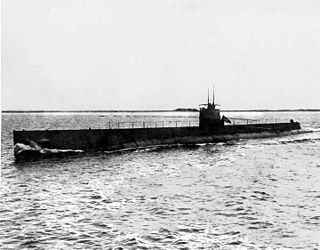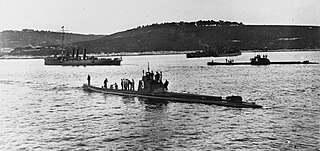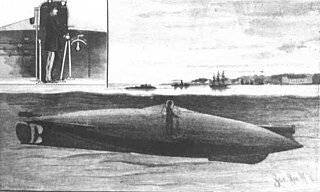
A submarine is a watercraft capable of independent operation underwater. It differs from a submersible, which has more limited underwater capability. The term is also sometimes used historically or colloquially to refer to remotely operated vehicles and robots, as well as medium-sized or smaller vessels, such as the midget submarine and the wet sub. Submarines are referred to as boats rather than ships irrespective of their size.

The 1880s was a decade of the Gregorian calendar that began on January 1, 1880, and ended on December 31, 1889.

John Philip Holland was an Irish engineer who developed the first submarine to be formally commissioned by the US Navy, and the first Royal Navy submarine, Holland 1.

USS Holland (SS-1) was the United States Navy's first modern commissioned submarine, although not the first military submarine of the United States, which was the 1775 submersible Turtle. The boat was originally laid down as Holland VI at the Crescent Shipyard of Elizabeth, New Jersey for John Philip Holland's Holland Torpedo Boat Company, and launched on 17 May 1897. She was acquired by the USN on 11 April 1900 and commissioned on 12 October 1900, Lieutenant H. H. Caldwell commanding.

Fenian Ram is a submarine designed by John Philip Holland for use by the Fenian Brotherhood, the American counterpart to the Irish Republican Brotherhood, against the British. The Fenian Ram was the world’s first practical submarine. It was powered by a double acting Brayton ready motor which used kerosene fuel. It was able to dive & submerge successfully. The Ram's construction and launching in 1881 by the Delamater Iron Company in New York was funded by the Fenians' Skirmishing Fund. Officially Holland Boat No. II, the role of the Fenians in its funding led the New York Sun newspaper to name the vessel the Fenian Ram.

Intelligent Whale is an experimental hand-cranked submarine developed for potential use by the United States Navy in the 1860s.

USS Adder, later renamed A-2, was one of seven Plunger-class submarines built for the United States Navy (USN) in the first decade of the 20th century.

The AA-1 class was a class of three experimental submarines of the United States Navy, built toward the end of World War I, between 1916 and 1919, intended to produce a high-speed fleet submarine. The design was not a success and none of the submarines saw active service. However, the lessons learned were applied to the design of the later V-boats. The class was later renamed as the T class.

The United States' S-class submarines, often simply called S-boats, were the first class of submarines with a significant number built to United States Navy designs. They made up the bulk of the USN submarine service in the interwar years and could be found in every theater of operations. While not considered "Fleet Submarines" in the traditional sense of that term, they were the first submarines in the USN designed for open ocean, blue water operations. All previous submarines had been intended for harbor or coastal defense. These boats were intended to have greater speed and range than previous classes, with improved habitability and greater armament.

USS O-10 (SS-71) was an O-class submarine of the United States Navy. Her keel was laid down on 27 February 1917 by the Fore River Shipbuilding Company in Quincy, Massachusetts. She was launched on 21 February 1918 sponsored by Mrs. John E. Bailey, and commissioned on 17 August 1918.

The K-class submarines were a class of steam-propelled submarines of the Royal Navy designed in 1913. Intended as large, fast vessels with the endurance and speed to operate with the battle fleet, they gained notoriety and the nickname of "Kalamity class" for being involved in many accidents. Of the 18 built, none were lost through enemy action, but six sank, with significant loss of life, in accidents. Only one ever engaged an enemy vessel, K-7 hitting a U-boat amidships, though the torpedo failed to explode with what has been described as typical "K" luck; K-7 escaped retaliation by steaming away at speed.

German submarine U-550 was a Type IXC/40 German Navy U-boat built during World War II. She was laid down on 2 October 1942 by Deutsche Werft in Hamburg as yard number 371, launched on 12 May 1943 and commissioned on 28 July under the command of Kapitänleutnant Klaus Hänert.
The history of the submarine spans the entire history of human endeavour as mankind has since early civilisation sought to explore and travel under the sea. Humanity has employed a variety of methods to travel underwater for exploration, recreation, research and significantly, warfare. While early attempts, such as those by Alexander the Great, were rudimentary, the advent of new propulsion systems, fuels, and sonar, propelled an increase in submarine technology. The introduction of the diesel engine, then the nuclear submarine, saw great expansion in submarine use – and specifically military use – during World War I, World War II, and the Cold War. The Second World War use of the U-Boat by the Kriegsmarine against the Royal Navy and commercial shipping, and the Cold War's use of submarines by the United States and Russia, helped solidify the submarine's place in popular culture. The latter conflicts also saw an increasing role for the military submarine as a tool of subterfuge, hidden warfare, and nuclear deterrent. The military use of submarines continues to this day, predominantly by North Korea, China, the United States and Russia.
The Austro-Hungarian U-boat fleet was created in the decade prior to the First World War. They were built to a variety of designs, many under licence from Germany. They served throughout the war against Italian, French and British shipping in the Mediterranean Sea with some success, losing eight of the twenty eight boats in service in return. They were reinforced by the Imperial German Navy’s Pola Flotilla, mainly comprising coastal U-boats transported by rail from Germany's northern shipyards to the Austrian ports on the Adriatic Sea. Following the end of the war in 1918, all Austrian submarines were surrendered to the Entente powers, who disposed of them individually. As both Austria and Hungary became landlocked in the aftermath of the war, no Austrian or Hungarian submarines have been commissioned since.
German submarine U-95 was a Type VIIC U-boat of Nazi Germany's Kriegsmarine during World War II. She was laid down on 16 September 1939 by Germaniawerft at Kiel as yard number 600 and commissioned on 31 August 1940. In seven patrols, she sank eight ships for a total of 28,415 gross register tons (GRT) and damaged four other vessels for a total of 27,916 GRT.

The U-3 class was a class of two submarines or U-boats built for and operated by the Austro-Hungarian Navy. The U-3-class boats were designed and built by Germaniawerft of Kiel, Germany. The class was a part of the Austro-Hungarian Navy's efforts to competitively evaluate three foreign submarine designs.
German submarine U-585 was a Type VIIC U-boat of Nazi Germany's Kriegsmarine during World War II.

Holland Torpedo Boat Company was founded by John Philip Holland in 1893. Holland was an Irish engineer-inventor, who designed and built the first practical submarine. His Holland VI was renamed the USS Holland (SS-1), and became the US Navy's first submarine. In 1899 the Holland Torpedo Boat Company became part of the Electric Boat Company.

Holland Torpedo Boat Station is where the first United States Navy submarines were stationed for trials and training of submarine crews from 1899 to 1905. Holland Torpedo Boat Station was located in the community of Hamlet in New Suffolk, New York. Hamlet claims to be the first submarine base in the United States. The USS Holland was based at Hamlet's Holland Torpedo Boat Station from 1899 to 1905. Seven submarines built by the Holland Torpedo Boat Company – Electric Boat Company were stationed at Hamlet. Holland Torpedo Boat Station at Cutchogue Harbor was not designated a submarine base by the US Navy. The US Navy gave that title to Naval Submarine Base New London as the first submarine base. Naval Submarine Base New London was commissioned by the US Navy in 1916 as a dedicated submarine base.

The Holland IV , also called the Zalinski Boat, was an experimental submarine built by John Philip Holland and financed by United States Army Lieutenant Edmund Zalinski in 1885. For the project Holland and Zalinski founded the Nautilus Submarine Boat Company (1885-1886).
















